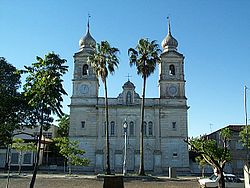Bagé
| Município de Bagé | |||
|---|---|---|---|
| Municipality | |||
 |
|||
|
|||
 Location in Rio Grande do Sul, Brazil |
|||
| Coordinates: 31°19′51″S 54°06′25″W / 31.33083°S 54.10694°WCoordinates: 31°19′51″S 54°06′25″W / 31.33083°S 54.10694°W | |||
| Country | Brazil | ||
| Region | South | ||
| State | Rio Grande do Sul | ||
| Founded | 1811-07-17 | ||
| Government | |||
| • Mayor | Luís Eduardo Colombo dos Santos (PT) | ||
| Area | |||
| • Total | 4,095.5 km2 (1,581.3 sq mi) | ||
| Elevation | 212 m (696 ft) | ||
| Population (2010) | |||
| • Total | 116,792 | ||
| • Density | 29/km2 (74/sq mi) | ||
| Demonym(s) | Bageense | ||
| Time zone | UTC-3 (UTC-3) | ||
| • Summer (DST) | UTC-2 (UTC-2) | ||
| Postal code | 96400 | ||
| Area code(s) | (+55) 53 | ||
| Website | bage.rs.gov.br | ||
Bagé is a municipality in the south of the state of Rio Grande do Sul, Brazil. In 2007 its population was 164,550 (IBGE) in a total area of 4,096 km2. It was the tenth largest city in the state in 2007
Bagé is located 374 km. southwest of the state capital, Porto Alegre and approximately 60 km north of the border with Uruguay at Aceguá. The distance to Pelotas to the east on BR 293 is 180 km. Other distances from Bagé are:
Santana do Livramento: 170 km. Jaguarão: 199 km. Santa Maria: 250 km. See Aonde Fica and Prefeitura Municipal de Bagé for distances.
Comandante Gustavo Kraemer International Airport serves the city and the region although currectly no scheduled flights operate to and from it.
At an elevation of 242 meters above sea level just south of latitude 30° Bagé has a mild climate with maximum temperatures of 30 °C in January and 17 °C in June and minimum temperatures of 18 °C in January and 8 °C in June. Rainfall is spread out throughout the year with a maximum of 140.9 mm in July and a minimum of 103.1 mm in April.
The economy is based on services, light industry and agriculture. Transformation industries employed 2,460 workers in 2006 while there were 1,199 agricultural establishments on 300,000 hectares employing 3,500 workers. There were 319,000 head of cattle and 103,000 head of sheep in 2007. The main crops were rice, corn, soybeans, sorghum, and wheat.
Because of its location on the shortest route between Porto Alegre and Montevideu, Bagé has always played an important role in the history of Brazil and the state of Rio Grande do Sul. Its lands have been sought after by Indians, Portuguese, and the Spanish. Here were played out important events of the Cisplatine War and the Farroupilha and Federalist Revolutions.
...
Wikipedia


